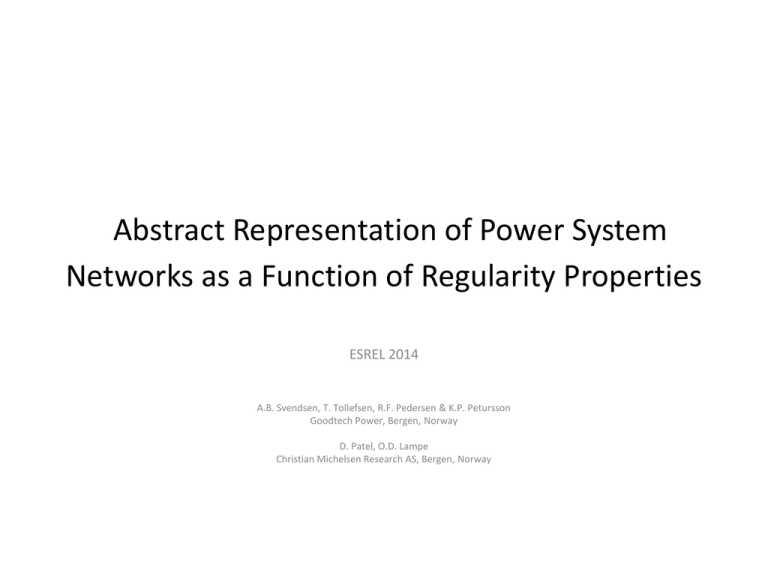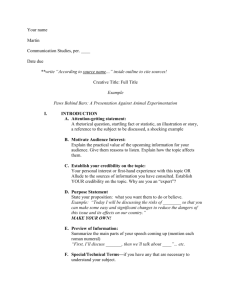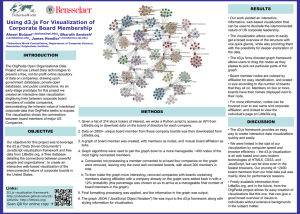PowerPoint-presentasjon
advertisement

Abstract Representation of Power System Networks as a Function of Regularity Properties ESREL 2014 A.B. Svendsen, T. Tollefsen, R.F. Pedersen & K.P. Petursson Goodtech Power, Bergen, Norway D. Patel, O.D. Lampe Christian Michelsen Research AS, Bergen, Norway Content • Part 1: Online risk simulator in operation at Statnett • Part 2: Visualization Part 1: Promaps Online Probability method applied to power system, Online calculations Introduction • In 2013 the first online risk calculator was put in operation for Norway’s Transmission system operator, Statnett. • The model repressing the Norwegian power system, includes a part of the Swedish and Finland power system. • Model size: >7000 branches, > 3000 nodes and data update every 10 minutes. • Promaps Online gives new insight regarding risk in power system, that is updated every 10 minutes • With all this new data, new ways for representing the power systems property regarding the changing risk, is needed. Background It started with a storm called Narve hitting Mid- and Northern Norway in 2006 A need presented itself; to be able to calculate the risk level during operation and for the following hours… – To be aware of the current situation – Planning of measures in areas that cannot handle the consequence of power outage The scope of work In 2009 Statnett R&D started collaborating with Troll Power (now Goodtech) on developing an online risk simulator of power systems The requirements were to be able to calculate: – The risk level in the entire Norwegian power system every 5 minutes – Receive power system data from EMS Scada – Present the risk level with a few colour parameters along with a dynamic colour indicating risk – «a glance at the screen» Status Promaps Norway model Norway model Regions Sub regions The challenges • It became obvious that it was needed a better way to get system insight, fast. • We need to understand underlying property of the power systems, which are changing every 10 minutes. • In the current way it is too much information to process to get a grasp on this property. The inspiration Part 2 Visualization • Current visualization techniques with geographically fixed nodes and straight lines have issues: – Limited information can be shown – To show the entire grid, multiple large screens must be used, making it hard to get an overview – Visualizations are static and do not show the most relevant information • We present three graph visualization techniques – edge bundling, – focus and context visualization and – non-geographic graph layout with clustering. Edge bundling (Cui, 2008) Our result Focus and context visualization • Standard visualization of power system. • SMS levels on nodes colored with scale green-yellow-red. • Percentage of max flow on edges with scale blue-yellow-red • Notice red area to the left Focus and context visualization • A focus and context map where important area is zoomed in on displacing the nodes and edges around but maintaining an overall correct geographic placement of the nodes. • One can imagine a dynamic system automatically creating multiple zoom-ins on areas of importance. Focus area Non-geographic Graph Layout with Clustering Cluster correspondences Supernodes and superbranches reorganized and given quantitaive values Conclusions • After installing the new simulation tool for reliability studies at Statnett SF, the need for a customized presentation method has become prominent. • The most promising approach has been the graph layout with clustering. This approach gives the opportunity to, by a single look at the screen, identify the most critical cuts, and get an overview of the risk level in each area along with the state of the power system as a whole. By zooming in on a cluster, more information regarding the risk related to each individual branch and bus is shown. • The focus and context approach is particularly suitable if the operators want a complete overview of the power system, while still being able to identify individual critical components. It offers a great way of visualizing changes in a network over time, as different parts of the system will be prominent, depending on the current risk level in each area. • Edge bundling is suited to use in combination with the focus and context approach, as branches in areas of little interest can be bundled together, in order to simplify the presentation.







